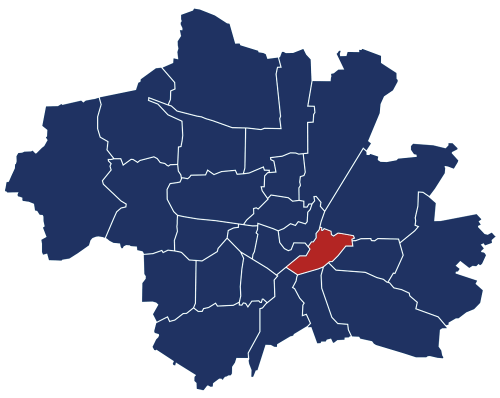Au – Haidhausen
Historical Background of Au-Haidhausen
Au (from “Land am Wasser” – land by the water) and Haidhausen (from “Heidhusir” – houses on the heath), the two suburbs incorporated into Munich on October 1, 1854, on the eastern Isar terrace, have parallel historical developments. Both were once hostel neighborhoods for craftsmen and day laborers outside the gates of Munich. Furthermore, a distinctive feature of the present-day district 5 was the many breweries located there, which found ideal conditions on the high banks of the Isar, such as the construction of deep wells and storage cellars. The only brewery still producing there today is “Paulaner.”
One of the most significant historical events in this district is the first assassination attempt on Adolf Hitler, which took place in the Bürgerbräukeller but failed. During the subsequent Second World War, 4/5 of the buildings in Au were destroyed. Haidhausen’s historic cityscape largely remained intact.
Location
The district of Au-Haidhausen is located almost centrally in the heart of Munich. Au lies opposite the Old Town on the eastern side of the Isar and forms the southern part of the district, while Haidhausen occupies the northern part, as well as the rest of the area. District 5 borders Bogenhausen to the north, Berg am Laim to the east, Obergiesing-Fasangarten, and Untergiesing-Harlaching to the south. Au-Haidhausen can be further divided into its six constituent district parts: 5.1 Maximilianeum, 5.2 Steinhausen, 5.3 Haidhausen-North, 5.4 Haidhausen, 5.5 Upper Au, and 5.6 Lower Au.
Building structure
It all began with hostels for craftsmen and day laborers. Later, breweries followed, as they recognized the ideal location on the high banks of the Isar. As a result, a large number of breweries settled there, including the “Hofbräu” brewery, which is now based in Riem, and the “Paulaner” brewery, which is still located there today. As relics of this era, there are still restaurants today that use the brewery buildings, such as the Hofbräukeller.
While more than half of the housing stock in Au, with its characteristic old hostels, was destroyed during the war, the historic cityscape of Haidhausen, including the “French Quarter” around Pariser Platz, was largely preserved. However, Haidhausen was not spared from the passage of time and the deterioration of building materials, leading to it becoming a major renovation area in the 1970s. The subsequent upgrading of the district resulted in a shift in its image. From its origins as a hostel district and through the post-war economic recovery, Haidhausen transformed from a working-class neighborhood into today’s trendy and entertainment district. This change has led to an imbalance between residential and commercial use, with a surplus of residential spaces and the relocation of commercial activities.
However, not everything is in flux. One of the most important buildings in Munich, if not Bavaria, is located in this district: the “Maximilianeum.” It is the seat of the Bavarian Parliament and thus of great significance. Also located here are the “Rechts der Isar” hospital and the Social Affairs Department of the City of Munich. As a connection to the city center, there is the cultural center “Gasteig,” which, together with the Muffat-Kulturhalle, forms a central hub for music and cultural life in Munich.
Population
A total of 58,881 residents currently live in the district of Au-Haidhausen. Due to the small area of 421.96 hectares, this results in a population density of 140 residents per hectare. This is the third-highest population density in all of Munich. The percentage of foreign nationals is 22.2%, slightly below the city average. However, there is a steady increase in population. This is most noticeable in migration, which has increased by +1,846, and in natural population growth, where there is a surplus of births (+335).
Age Structure in Au-Haidhausen
The “15 to under 45-year-olds” make up the largest age group, with 29,744 residents, which constitutes 50.52% of the population.

Age Structure of Au-Haidhausen
This indicates a large clientele for RE/MAX, as nearly 50% of the residents are in the age group that is likely to buy or rent a home, or are planning to make a change, and have the financial means to do so.
Numbers and Facts
- Area: 421.96 hectares
- Population: 58,881 residents
- Population density: 140 residents per hectare




